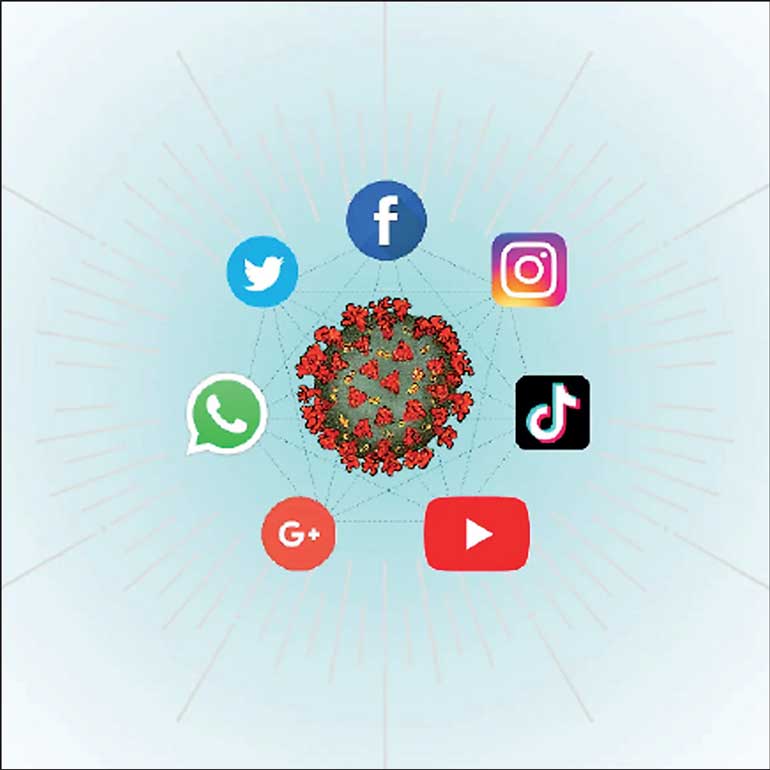Thursday Jan 15, 2026
Thursday Jan 15, 2026
Monday, 14 June 2021 00:00 - - {{hitsCtrl.values.hits}}

With the presence of more than 10 million Sri Lankan internet users, the increasing trend of using the SNWs for multiple purposes is obvious. The necessity to work from home has further intensified it
 Social media has increasingly become a part of our daily lives, with respect to its attractiveness. It can have a developmental or detrimental approach towards something or someone. We have often seen how it can jumble fact with fiction in creating chaos. Today’s column is a discussion on the role of social media amidst a planetary pandemic with its associated promises and perils.
Social media has increasingly become a part of our daily lives, with respect to its attractiveness. It can have a developmental or detrimental approach towards something or someone. We have often seen how it can jumble fact with fiction in creating chaos. Today’s column is a discussion on the role of social media amidst a planetary pandemic with its associated promises and perils.
Overview
I came across an interesting article by Heena Sahni and Hunny Sharma, two medical researchers from India, highlighting both the constructive and destructive roles currently played by social media. As they observe, with over 560 million internet users, India became the world’s second-largest online market globally, ranking next to China. Of all the social media available in India, the most popular social networking sites are YouTube and Facebook. Indeed, India has the largest Facebook user base in the world. WhatsApp, Instagram, and Facebook Messenger are recently a few of the other famous social networking sites used in India.
People use mobile phones too much nowadays that it may cause medical implications. Likewise, a study reported by The Lancet described ‘WhatsAppitis’ in which a young woman had wrist pain because of sending too many messages from her phone. This is interesting in a time where almost every person is having internet in their cell phones and laptop and everyone is capable of sending text messages and information, nowadays instead of ‘alert’, panic’, that transmits faster when compared to COVID-19 itself.
Social media in a ‘social age’
“Social media has taken the world by storm, leaving many people in the dust,” so says Adam Grant, Professor at Wharton Business School. This aspect is further elaborated by Ted Coine and Mark Babbit in their insightful book titled, ‘A World Gone Social’, where they stress, “The Industrial Age is dead; welcome to the Social Age.” According to them, “Social media has proven to be an insurmountable market force, changing how we innovate, collaborate, serve our customers, hire and develop team members, motivate others toward a common mission, communicate with stakeholders, display our character, and demonstrate accountability.”
It is interesting to note that about 71% of the world’s internet users are youth aged 15-24. As Heena Sahni and Hunny Sharma observe, in India, there were 197 million active social media users (14% of the total population), by early 2020. According to the 2014 Digital Health Literacy Survey among European Citizens, 59% of Europeans used the internet to check for health information. 55% requested general information, 54% requested information about a particular illness, 23% sought detailed information on a diagnosis, and 10% used the net to get a second opinion after consulting their physician. Approximately 82% and 87% of people looking for health-related information used search engines for their queries.
The researchers cite a second source of information (47%-48% people) was relevant and dedicated websites such as health blogs and forums, while between 33% and 38% were looking for information from official health websites, such as the Ministry of Health or the WHO. Another study performed by Public Health Dentists of Bengaluru India in 2014 revealed that out of 572 study participants, 150 (26.2%) reported the use of the internet for oral health-related information, overall, more than 80% of the respondents preferred the use of Google as their search engine but when asked about any research article and journal website they could not picture anything.
At this time, when no other ways are available to cure or manage COVID-19 other than quarantine and social distancing, social media has become a strong platform for spreading public health awareness and advocacy regarding public health issues. Some nations do have Twitter and Facebook accounts for these purposes. An active page on Twitter and Facebook as these platforms allow users to post large numbers of short messages in less period (known as Microblogs); also, these organisations use to monitor ‘tweets’ that may signify any outbreak and share information on events of this nature.
Social networking sites also serve as a way for disaster management, outbreak prevention, and emergency response staff to easily communicate and access critical information collected by organisations like the WHO and the Center for Disease Control. A study showed that during the Ebola (2014) and Zika (2015) outbreak, social networks helped to establish active communications with the community and then applied it to improve in public health.
Another evidence indicates that in 2016, when the WHO declared Zika virus as a danger to the world, social media monitoring and prevention awareness messages played as a lifesaving role in enhancing risk control and disease management.
 Glimpses of a global study
Glimpses of a global study
Although young people are less at risk of severe disease from COVID-19, they are a key group in the context of this pandemic and share in the collective responsibility to help us stop transmission. They are also the most active online, interacting with an average number of five digital platforms (such as, Twitter, TikTok, WeChat and Instagram) daily.
According to the above WHO report, to better understand how young adults are engaging with technology during this global communication crisis, an international study was conducted, covering approximately 23,500 respondents, aged 18-40 years, in 24 countries across five continents. This project was a collaboration between the World Health Organization (WHO), Wunderman Thompson, the University of Melbourne and Pollfish. With data collected from late October 2020 to early January 2021, the outcomes provide key insights on where Gen Z and Millennials seek COVID-19 information, who they trust as credible sources, their awareness, and actions around false news, and what their concerns are.
As the report further observed, when asked what COVID-19 information (if any) they would likely post on social media, 43.9% of respondents, both male and female, reported they would likely share ‘scientific’ content on their social media. This finding appears to buck the general trend on social media where funny, entertaining, and emotional content spread fastest. More than half (59.1%) of Gen Z and Millennials surveyed are ‘very aware’ of ‘fake news’ surrounding COVID-19 and can often spot it. However, the challenge is in recruiting them to actively counter it, rather than letting it slide, with many (35.1%) just ignoring.
According to the said survey findings, Centennials (Generation Z) and Millennials (Generation Y) have multiple worries beyond getting sick. While it is often suggested that young adults are ‘too relaxed’ and do not care about the crisis, this notion is not reflected in the data, where over 90% of respondents were very concerned or somewhat concerned about the risk of infection. Beyond getting sick themselves, the top concern of respondents (55.5%) was the risk of friends and family members contracting COVID-19, closely followed by the economy crashing (53.8%).
The report highlights the need to navigate their digital world safely and make choices to not only protect their health but also the health of their families and communities. These insights can help health organisations, governments, media, businesses, educational institutions, and others sharpen their health communication strategies. Ensuring policy and recommendations are relevant to young people in a climate of misinformation, scepticism, and fear.
Useful recommendations
As Heena Sahni and Hunny Sharma further observe, “A significant amount of potentially dangerous misinformation has been generated about the COVID-19 pandemic, and much of it has been disseminated via social networks.” This misleading news consists of different facets of the pandemic, which is capable of threatening public safety, which again aggravates crisis management. This false rumour about COVID-19 is disseminated faster than the virus, and it appears that the healthcare professionals are actively battling against two faces of the virus and the associated misinformation simultaneously.
The key approach suggested by the researchers was also to correct misconceptions by health institutions’ experts. Although some studies stress that correct knowledge can be unsuccessful during any public health crisis, at the same time much research demonstrated the efficacy of providing and transmitting truthful facts by health experts. They also suggest various methods for correcting misconceptions about health through social media, which involves timely expert advice, regular public health awareness, and correction program with periodic communication among general people and on media algorithms.
“We also want to draw attention to a correction program which will be successful if it is applied quickly and clearly, along with relevant document, at the same time evidence should also be provided and shown to the public,” say the two researchers. With all these above-mentioned ways one should always address the intellectual and emotional dimensions of the audiences during this continuing phase of fear and anxiety. As the virus tends to be spreading rapidly and demands regular attention, correct communication is a critical aspect. The lessons being learnt during this COVID-19 outbreak will serve as a blueprint for coping with future pandemics, with new sustainable standards being developed.
Way forward
We have to continue with a contagion that takes us through confusing contours. At the same time, we have seen the media reports of the good, bad and the ugly use of Facebook in Sri Lanka. Some spend more time connected with Facebook friends without even showing their face to the loved ones near and dear. With the presence of more than 10 million Sri Lankan users of internet, the increasing trend of using the SNWs for multiple purposes is obvious. The necessity to work from home has further intensified it.
There may be policy issues and procedure inadequacies. Yet, the fact remains that the emerging workforce is more tech-savvy and internet-friendly. Rising popularity of the internet usage for socially-critical events such as releasing of exam results, and utility payment gateways, is a promising sign. Much could be done with both creativity and control in order to ensure reaping the richness of social age.
(The writer, former Director of Postgraduate Institute of Management, can be reached through [email protected], [email protected] or www.ajanthadharmasiri.info.)